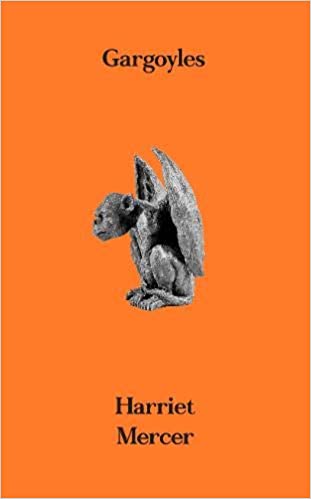Review by Moss Pepe
The disease hath established a kingdom, an empire in me, and will have certain secrets of state, by which it will proceed and not be bound to declare them.
– John Donne, Devotions upon Emergent Occasions
Harriet Mercer’s hybrid memoir Gargoyles tells the story of the author’s own experience of a catastrophic haemorrhage of the blood vessels on an angiomyolipoma (a benign tumour) and her time in hospital following her sudden and near-fatal collapse. I read Gargoyles in a kind of fugue state, and am writing this from my own kingdom of disease, from a place of personal illness (Long Covid has made an empire in me, etc, etc), and from a country that has declared its paradoxical stance on public health by enshrining the ‘freedom’ of its public to become unwell. Approaching Gargoyles from this particular vantage, in pandemia and suffering from an illness which currently exists without any useful understanding of cause or cure, has brought welcome perspective not only of how one processes illness and its aftershocks, but of the altered perspective/s accompanying such an experience. The foundation of the book is Mercer’s time in hospital, yet Gargoyles is far more than a ward memoir. Although she paints her stay in hospital with great care, wit and precision, Mercer also carefully thinks through ideas of communities of care, deviations from life’s expected paths, theories of sickness, and the complexities of writing any account of illness or pain.
Mercer is not only a lyrical and eclectic writer, but an attentive reader of the work of others. Part memoir, part essay, her attention throughout Gargoyles floats between books, art, and blockbuster films. In a chapter in which she examines the various approaches to writing illness, Mercer’s focus lands on Jean Dominique Bauby’s The Diving Bell and the Butterfly, the French Vogue editor’s 1997 memoir. Bauby’s life was irrevocably changed by a car crash that left him mute and only able to move his left eye and eyelid. I was made to read the book in secondary school, where much was made of its composition – Bauby blinked each individual letter to an amanuensis – and very little attention seemed to be placed on what he was saying. This treatment meant that the poignancy of his reflections was broadly lost on me. Bauby divides the residents of the hospital into two camps – the long-term population of ‘denizens,’ and the ‘tourists,’ whose stay was short-lived. His framing folds illness into place, and Bauby spends much of his time visiting foreign climes in his mind’s eye. The above quotation from Donne appears in Gargoyles as an internalising of the place-ness of illness, and is also elaborated on by a quotation from Susan Sontag’s AIDS and Its Metaphors, which Mercer tucks away in the footnotes:
‘Everyone who is born holds dual citizenship, in the kingdom of the well and the kingdom of the sick.’
This analogy further riffs off of the idea of sickness as place, and yet the notion of dual citizenship conjures a here and there of sickness, an either/or logic that does not hold up to a great deal of scrutiny. Mercer sets up a similar binary at the beginning of her book, which at first glance conveys a structuring belief in the clean divide between sickness and health, with the initial chapters of the book alternating between a terrifying first-person account of sudden and serious illness, and the un-sick space of the before or after. Yet Mercer deftly and subtly unpicks this framing as the book progresses, through increasingly rich and complicated interactions between the here and there of sickness and health that erode any certainty of the usefulness of such a distinction.

The title of the book refers to the recurring hallucinatory vision of snarling gargoyles that descend upon Mercer every time she closes her eyes to sleep, and these revelatory descriptions of the delirium of acute sickness are as mesmerising as they are disconcerting. However, rather than gargoyles, the book is populated by the myriad methods Mercer employs to avoid calling them into being. To stop the world ‘dissolving into gargoyle,’ she devises and practices an open-eyed fixation on that which is definitely physically there, a perpetual watch from which she rarely allows herself to take a break. As a result of these nightmares, Mercer’s stay in hospital becomes an intense and gruelling exercise in forced wakefulness: she rejects strong painkillers, only allows herself to doze under the supervision of her family, and stays awake all night tracing the tiles of the ceiling with her eyes. Her refusal to sleep means that the gargoyles are replaced by waking dreams. Hallucinatory sequences gently unfold, abruptly interrupt or subtly alter the grammar of everyday speech and life. These reveries are sometimes intensely felt memories or phantasmic visions: the hospital’s unfortunately named Pain Team morph into an absurd lacrosse squad, hospital curtains become an opulent tunnel ‘that might be a silk worm’s cocoon,’ old letters written by her father as a child play out in bucolic vignettes. The resulting prose is dynamic, wide-ranging and poetic. A kind of total vigilance permeates the book, as Mercer scours not only the ward but her entire life to find that her illness was, in fact, ‘the richest of life’s lessons.’
This obsessively visual living is also informed by Mercer’s love of photography. The book’s collage-like prose – jolting and fading between narration, dream, letter, memory, reported speech, literary criticism – feels all the richer for the inclusion of the writer’s own photographs. Her meticulous descriptions of scenes and objects are later crystallised by eerily reiterative images that reinforce the place of the visual within the text. This focus distils the way in which being incapacitated can preference the visual field, how the gaze can remain the sole domain of control. She also evokes the concomitant perspectival shifts that accompany acute illness, whether it be through the transformation of the text of a newspaper into ‘Himalayan terrain,’ or the impossibly widening distance between bed and chair, ‘how it can be that a few normal strides can span into infinity.’
Yet Mercer is interested not only in her own gaze, but also what others can see, experiencing her altered physical appearance first through the eyes of her friends and family. Their gaze brings new understanding along with it, the gravity of her situation only dawning on her by increment and at a remove. Thus those around her act as a mirror (‘her shock becomes my shock’), long before Mercer could physically reach one herself.
The unflinching nature of Mercer’s gaze is also present in that which she chooses not to look away from. Perhaps preempting what could be a reaction to her own work, she seeks out books that some tend to dismiss with the refrain: ‘No, no, I can’t read it, just too sad.’ She does not look away from the painful, the difficult, the ugly. Nor does she avoid eliciting intense emotion in the reader – we are not coddled – and yet this discomfort is balanced skilfully with humour, warmth and intelligence. Just as her mother not only provides Mercer herself with relief, reassurance, and calm, these same acts of care (the gift of an orchid, crossword clues, a well-timed raise of the eyebrows at a piece of ward gossip, chicken soup) carry through to the reader – or at least to me – who is soothed by the immovable constancy of her presence.
In the end, Gargoyles does not retread a typical and heroic journey of overcoming, with Mercer even admitting that she ‘felt guilty that I hadn’t fashioned a success story with the gift of recovery.’ By avoiding constructing such a narrative, she manages to make what is autobiographical remarkably outward-looking. Following her time in hospital, Mercer seems inexplicably drawn to others who have lived through similarly calamitous divergences from the everyday, and experiences ‘otherworldly’ encounters with people who have also survived near-death experiences. What results is a kind of communion of catastrophe, and a book that asks how people live through, after, within and around the catastrophic. It is a thinking that does not shy away from qualifying loss, but, by examining it in depth, finds not only what can be salvaged, but what might be gained.
Several years after her illness, Mercer walks the Spanish pilgrimage route, the Camino de Santiago, alone, and in another moment of serendipity meets a woman whose husband is undergoing treatment for cancer. She sums up their conversation as, simply, ‘We spoke a good deal about life and death.’ Gargoyles is a considered exploration of just that. Earlier in the book, Mercer quotes from Alphonse Daudet’s diaries concerning his slow and painful demise from syphilis, in which he paints his endeavour as a writer of sickness as impossible:
‘Words only come when everything is over, when things have calmed down. They refer only to memory, and are either powerless or untruthful.’
Mercer’s text firmly pushes against this claim, its crystalline descriptions of acute illness are so powerful that, at times, I found I had to put it down, or remind myself that it was indeed ‘referring only to memory.’ Though I hope if I have learnt anything from Gargoyles, it is not to look away.
Moss Pepe is a part-time PhD student working on transgender approaches to medieval romance. His poetry and essays have appeared in Close, The Skinny, Perverse, and elsewhere. He lives in Edinburgh.
Continue to a poem by Jenn Blair >>
